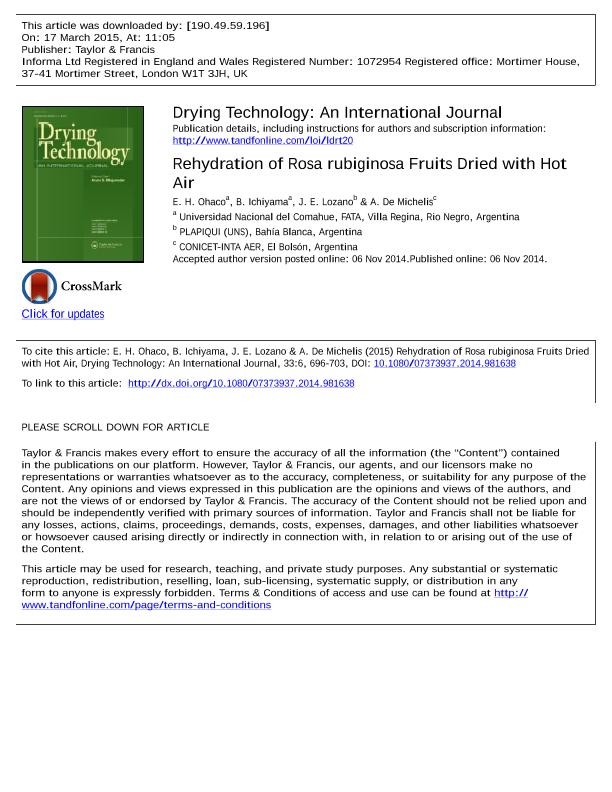Mostrar el registro sencillo del ítem
dc.contributor.author
Ohaco, Elizabeth
dc.contributor.author
Ichiyama, Beatriz
dc.contributor.author
Lozano, Jorge Enrique

dc.contributor.author
de Michelis, Antonio

dc.date.available
2017-10-03T17:41:51Z
dc.date.issued
2015-04
dc.identifier.citation
Ohaco, Elizabeth; Ichiyama, Beatriz; Lozano, Jorge Enrique; de Michelis, Antonio; Rehydration of Rosa rubiginosa Fruits Dried with Hot Air; Taylor & Francis; Drying Technology; 33; 6; 4-2015; 696-703
dc.identifier.issn
0737-3937
dc.identifier.uri
http://hdl.handle.net/11336/25786
dc.description.abstract
The effect of perforation, drying temperature, and rehydration temperature on the rehydration kinetics of Rosa rubiginosa fruits was investigated. Before drying, half of the fruit sample was perforated three times at equidistant points along the equatorial plane of the fruit, in order to speed up the drying process. Samples were dried at various air temperatures (60, 70, and 80°C), with an air velocity of 5 m/s and 5% relative humidity. Then, dried samples were rehydrated at different temperatures (20, 40, 60, and 80°C). The rehydration kinetics was fitted by two empirical models, Peleg and Weibull, and both represented the phenomenon well, in perforated and nonperforated fruits. Regardless of the drying temperature, the higher the rehydration temperature of rose hip fruits, perforated or not, the higher the water absorption capacity. Temperature dependence of the kinetic parameters was Ea = 47.5 kJ/mol (Peleg) and 55.9 kJ/mol (Weibull) for nonperforated fruits and Ea = 40.1 kJ/mol (Peleg) and 45.5 kJ/mol (Weibull) for perforated fruits; thus, perforated fruits were influenced more by rehydration temperature than nonperforated fruits. Perforated fruits rehydrated 30% faster than nonperforated fruits.
dc.format
application/pdf
dc.language.iso
eng
dc.publisher
Taylor & Francis

dc.rights
info:eu-repo/semantics/openAccess
dc.rights.uri
https://creativecommons.org/licenses/by-nc-sa/2.5/ar/
dc.subject
Rehidration
dc.subject
Rosa Rubiginosa
dc.subject
Fruit
dc.subject
Drying
dc.subject.classification
Alimentos y Bebidas

dc.subject.classification
Otras Ingenierías y Tecnologías

dc.subject.classification
INGENIERÍAS Y TECNOLOGÍAS

dc.title
Rehydration of Rosa rubiginosa Fruits Dried with Hot Air
dc.type
info:eu-repo/semantics/article
dc.type
info:ar-repo/semantics/artículo
dc.type
info:eu-repo/semantics/publishedVersion
dc.date.updated
2017-09-25T18:12:03Z
dc.identifier.eissn
1532-2300
dc.journal.volume
33
dc.journal.number
6
dc.journal.pagination
696-703
dc.journal.pais
Reino Unido

dc.journal.ciudad
Londres
dc.description.fil
Fil: Ohaco, Elizabeth. Universidad Nacional del Comahue. Facultad de Ciencias y Tecnologia de los Alimentos; Argentina
dc.description.fil
Fil: Ichiyama, Beatriz. Universidad Nacional del Comahue. Facultad de Ciencias y Tecnologia de los Alimentos; Argentina
dc.description.fil
Fil: Lozano, Jorge Enrique. Consejo Nacional de Investigaciones Científicas y Técnicas. Centro Científico Tecnológico Conicet - Bahía Blanca. Planta Piloto de Ingeniería Química. Universidad Nacional del Sur. Planta Piloto de Ingeniería Química; Argentina
dc.description.fil
Fil: de Michelis, Antonio. Instituto Nacional de Tecnología Agropecuaria; Argentina. Consejo Nacional de Investigaciones Científicas y Técnicas; Argentina
dc.journal.title
Drying Technology

dc.relation.alternativeid
info:eu-repo/semantics/altIdentifier/doi/http://dx.doi.org/10.1080/07373937.2014.981638
dc.relation.alternativeid
info:eu-repo/semantics/altIdentifier/url/http://www.tandfonline.com/doi/abs/10.1080/07373937.2014.981638
Archivos asociados
